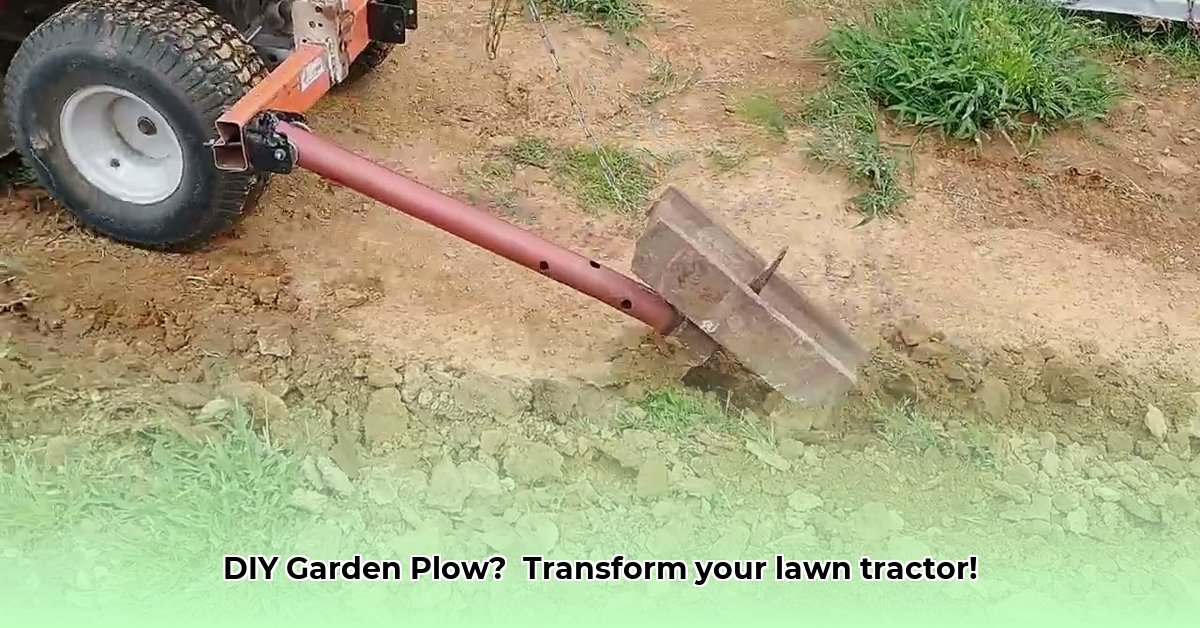
Want to transform your lawn tractor into a versatile gardening machine? Building your own garden plow is a surprisingly achievable project that saves money and allows for customization. This step-by-step guide provides clear instructions, safety precautions, and troubleshooting tips to ensure a successful build. Let's get started! For more tractor attachment ideas, check out this helpful resource: tractor attachments.
Getting Your Tractor Ready
Before you begin construction, assess your lawn tractor's capabilities. Can it handle the strain of plowing? Check its weight capacity and ensure the frame is structurally sound. Using a weak tractor for heavy plowing is like using a butter knife to fell a tree – it's dangerous and inefficient! If you're unsure about your tractor's suitability, consult a professional.
Gather Your Supplies: The Essential Shopping List
The specific materials depend on your design, but this list covers the basics:
- Steel: A sheet of steel for the plow blade. Thickness depends on your soil type – thicker steel for heavy clay, lighter steel for lighter soils. (Think heavy-duty for heavy-duty work!)
- Metal Framing: Angle iron or square tubing forms the plow's frame. Choose strong, durable materials for this critical component.
- Fasteners: Bolts, nuts, and washers – plenty of them! High-quality fasteners are essential for a secure and dependable plow.
- Welding Gear (Likely Needed): A welder provides stronger, safer joints than bolting. If you opt for bolting, expect less robust results and a higher risk in structural integrity during use. Welding requires proper training and safety precautions.
- Tools: Tape measure, spirit level, marker, cutting tools (appropriate for your chosen steel), and safety equipment.
- Safety Gear: Safety glasses, sturdy work gloves, and steel-toed boots are absolutely non-negotiable. Your safety is paramount!
Consider using recycled or sustainable materials whenever possible to reduce costs and environmental impact.
Designing Your Plow: Planning for Success
Sketch your plow design carefully. Consider these key factors:
- Plow Width: A wider plow covers more ground but increases stress on your tractor. Smaller tractors need narrower plows, so adjust accordingly.
- Plow Depth: How deep do you want to till? Deeper plowing demands more from your tractor.
- Blade Angle: The angle affects how the plow cuts through soil. Experiment with different angles during testing.
Numerous online resources offer design inspiration. Adapt these ideas to your needs and tractor capabilities.
Building Your Plow: A Step-by-Step Guide
Cutting the Steel: Cut the steel sheet precisely to your design's dimensions. Use the appropriate cutting tools and always wear your safety gear. Improper cutting can significantly impact performance and safety.
Creating the Frame: Weld or bolt the metal framing together, ensuring a strong and rigid structure. This is your plow's backbone; strength and rigidity are key. Use many high-quality bolts for bolted construction and check for deep weld penetration if you are welding.
Attaching the Blade: Securely attach the steel blade to the frame. Double or triple-check welds or bolts for a tight, secure fit. A loose blade is incredibly hazardous and dangerous.
Connecting to Your Tractor: Design a robust connection method between the plow and your tractor's hitch. This may involve adapting existing attachment points or fabricating new ones. Ensure a secure and reliable connection.
Testing and Refining: Perform test runs in a safe, open area. Observe the performance and adjust the blade angle and depth as needed. This iterative process is crucial for optimal results.
Safety First: Prioritizing Your Well-being
- Always wear safety gear. This is not optional; it's mandatory. Safety glasses, gloves, and steel-toed boots are essential for your protection.
- Inspect your equipment before each use. Check for loose components, and ensure everything is securely attached and in working order.
- Never operate the tractor under the influence of alcohol or drugs.
- Be aware of your surroundings. Watch out for obstacles, uneven terrain, and potential hazards.
- Take regular breaks. Plowing is physically demanding; fatigue increases risk.
Troubleshooting Common Issues
- Not cutting deep enough: Adjust the blade angle; steeper angles generally cut deeper but may strain the tractor.
- Excessive bouncing or vibration: You may have loose components; tighten all connections and ensure even weight distribution.
- Tractor struggling: Reduce the plow width or try a lighter soil. Evaluate if your tractor is powerful enough for the task.
Weighing the Pros and Cons
| Pros | Cons |
|---|---|
| Significantly cheaper than store-bought plows | Requires mechanical skills or assistance |
| Highly customizable | Durability may be less than commercial, heavy-duty models |
| Environmentally friendly (using recycled materials) | Requires time and effort to build |
| Rewarding DIY experience | Potential safety hazards if not carefully constructed |
Building your own garden plow is a fulfilling project. Prioritize safety and careful planning for a successful and worthwhile outcome. Happy plowing!